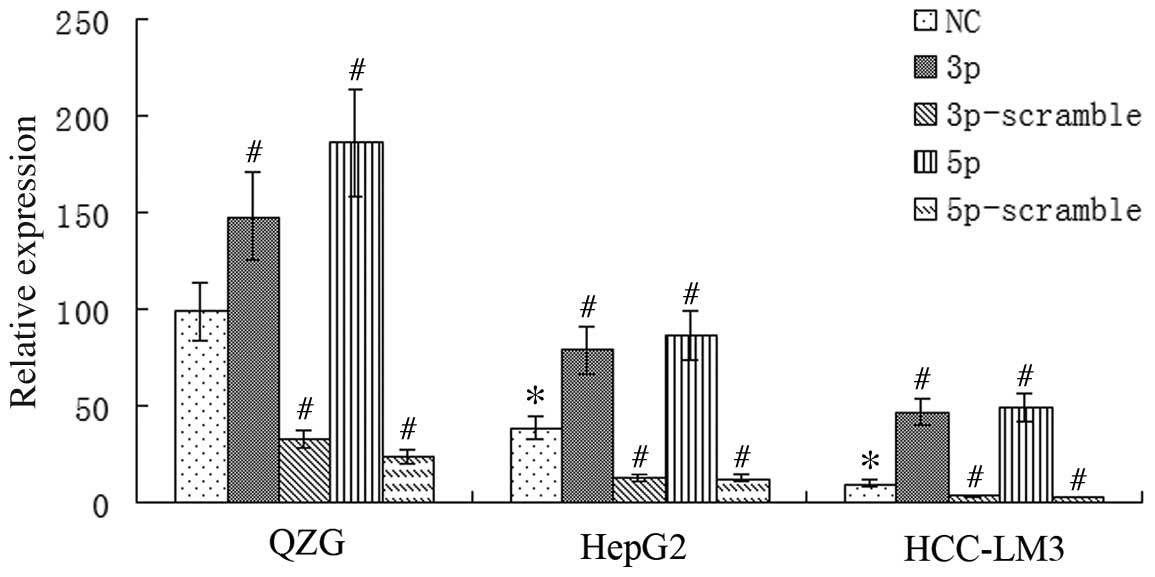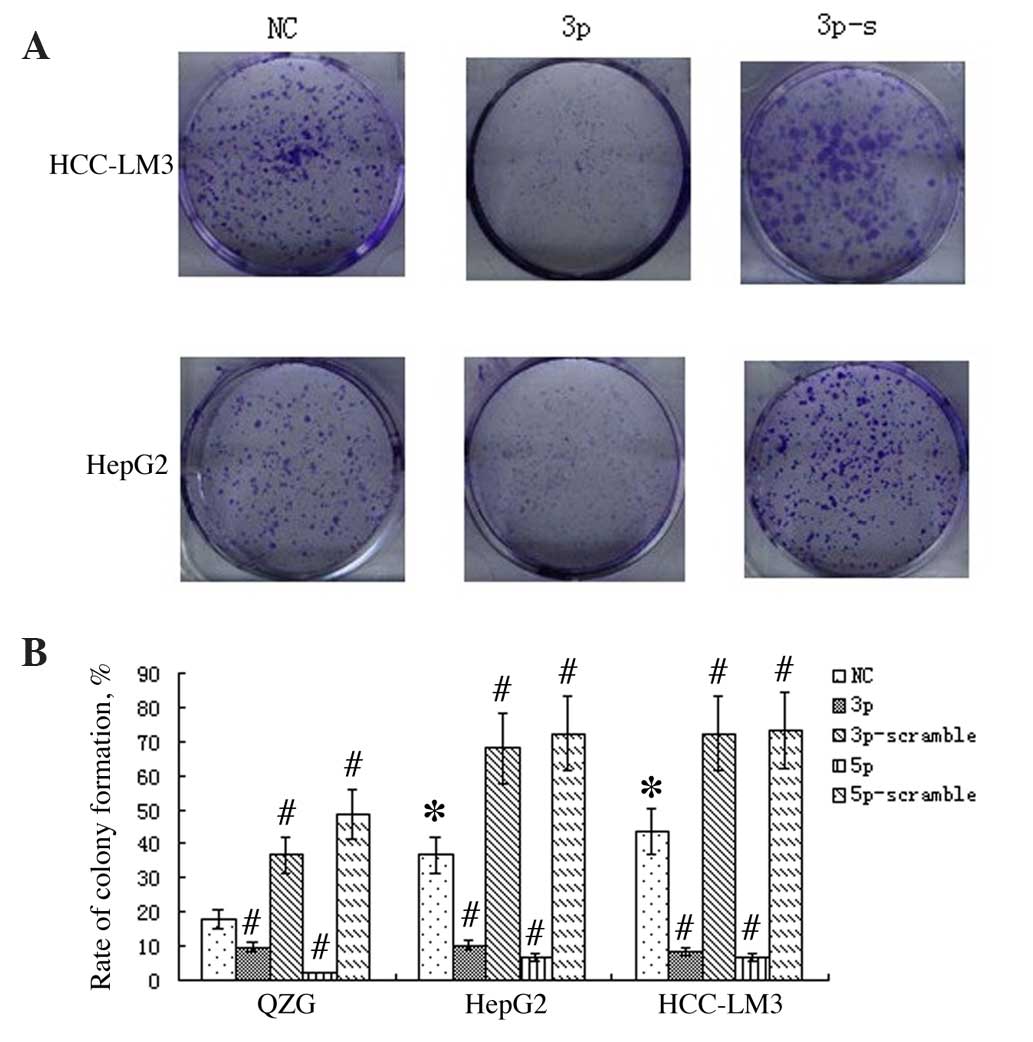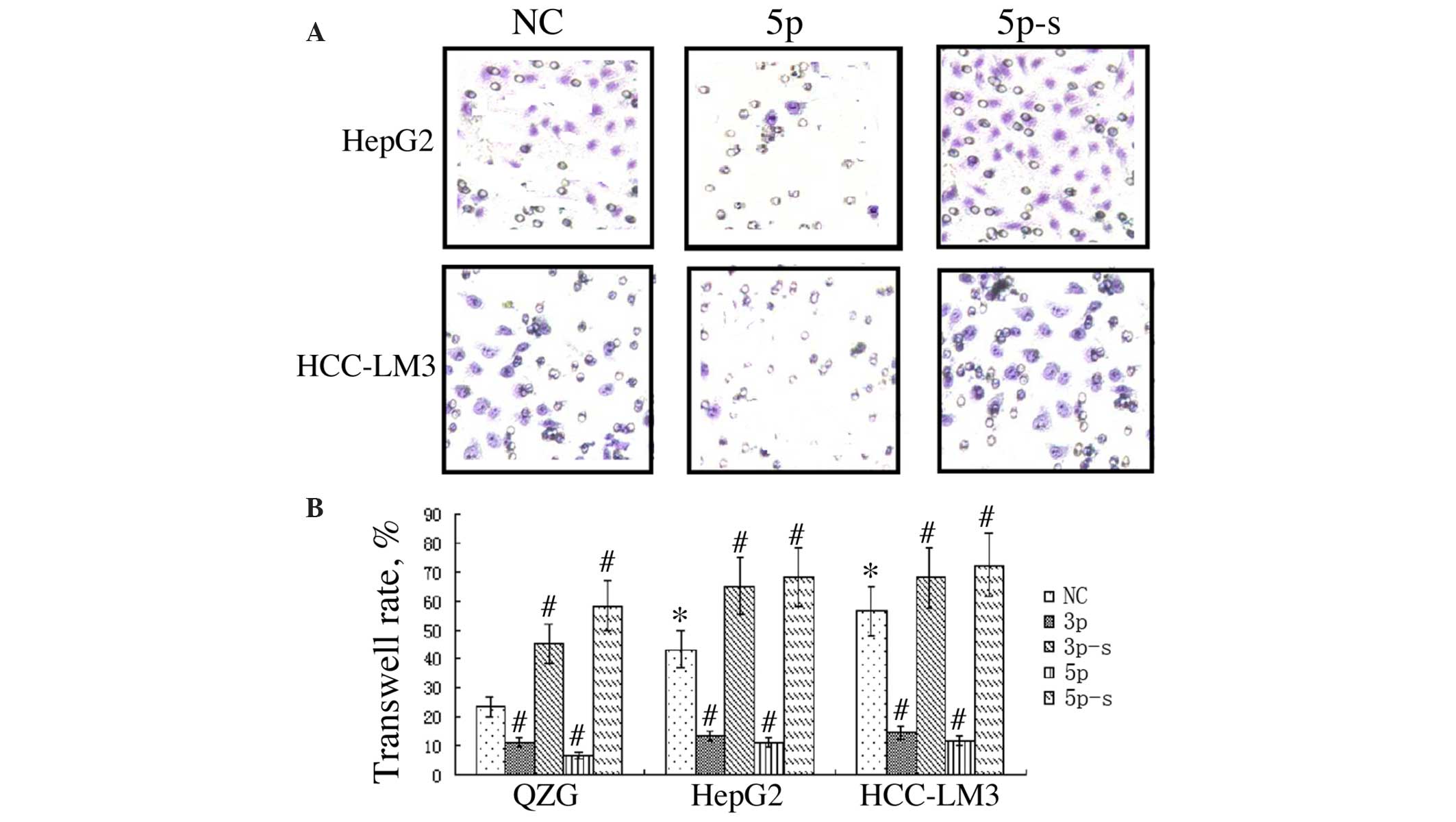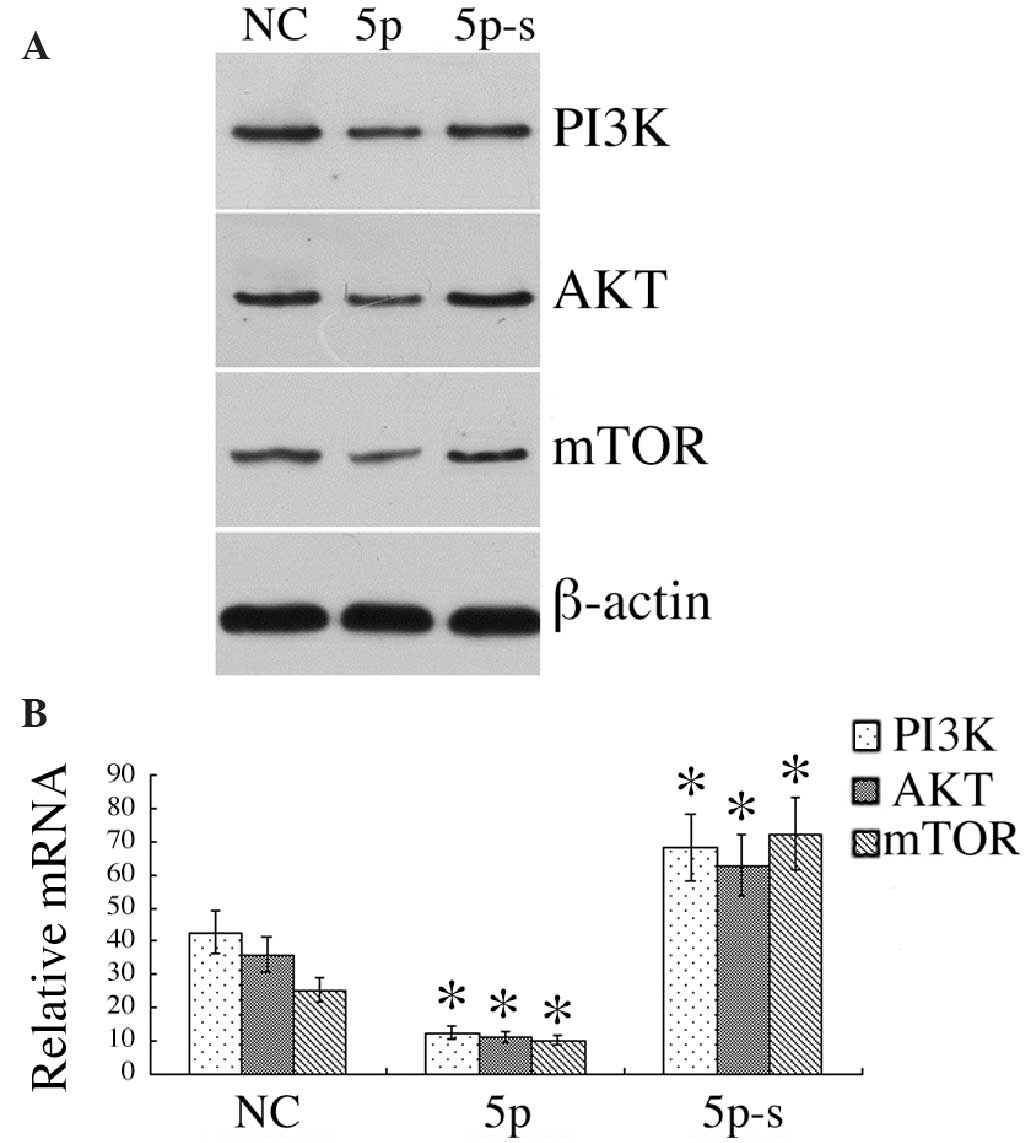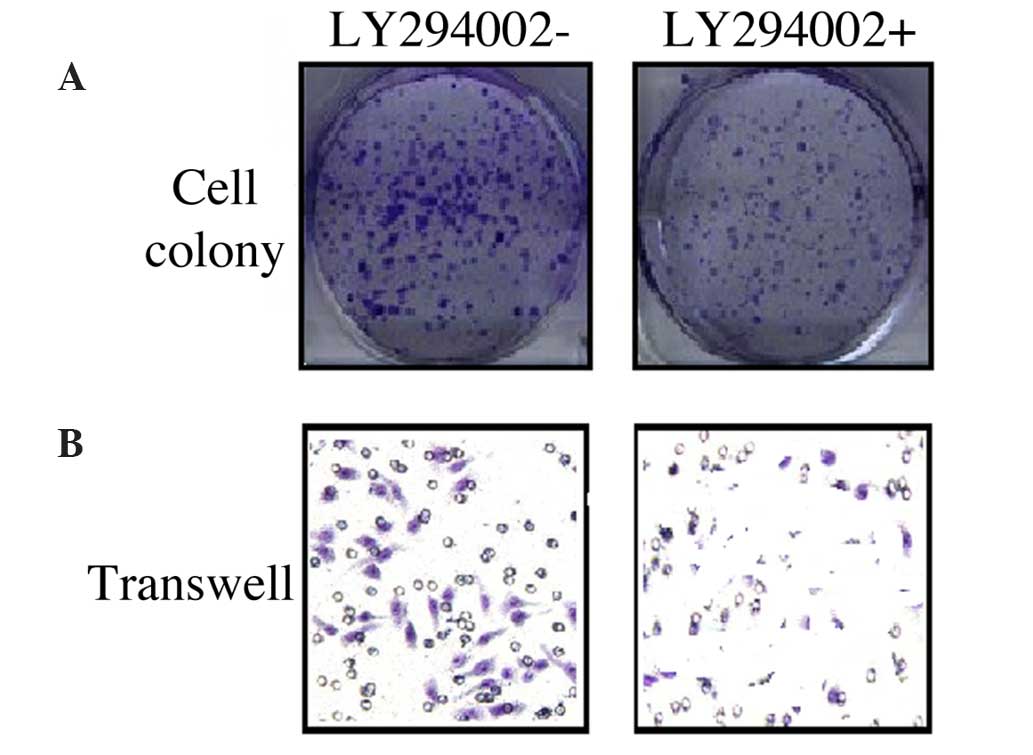miR‑125a inhibits the migration and invasion of liver cancer cells via suppression of the PI3K/AKT/mTOR signaling pathway
- Authors:
- Published online on: May 26, 2015 https://doi.org/10.3892/ol.2015.3264
- Pages: 681-686
-
Copyright: © Tang et al. This is an open access article distributed under the terms of Creative Commons Attribution License.
Abstract
Introduction
Hepatocellular carcinoma (HCC) is common malignant form of cancer associated with high incidence (28.71 per 100,000 in China) and mortality (26.04 per 100,000 in China) (1), which represents a critical threat to public health. To date, there is no effective treatment for HCC, and the lack of effective diagnostic techniques available, due to the undefined etiology and pathogenesis and high-grade malignancy, contributes to poor patient prognosis (2). Ascertaining the origin and development of liver cancer and identification of novel targets for therapy have been the focus of recent studies regarding HCC (3–7). MicroRNAs (miRs) are single-stranded noncoding RNAs, containing 17–19 nucleotides, which are associated with the development and progression of tumors (8–12) such as oropharyngeal squamous cell carcinoma (8), non-small cell lung cancer (9), thyroid cancer (10). miR-125a has previously been reported to block the proliferation, invasion and migration of breast cancer cells (13), and was also found to be effective in preventing the invasion of ovarian cancer (14), glioma (15), lung cancer (16–18) and gastric cancer (19). miR-125a has been demonstrated to be implicated in hepatitis B virus duplication and the progression of hepatitis B (20,21). Bi et al (22) observed that miR-125a inhibited the proliferation and migration of liver cancer cells by targeting matrix metalloproteinase (MMP)11 and vascular endothelial growth factor (VEGF). The phosphoinositide 3-kinase (PI3K)/AKT pathway enhances not only cell proliferation, but also cell invasion and migration (23). It has been demonstrated that another miRNA, miR-21, is able to control the proliferation of liver cancer cells by regulating the PI3K/AKT pathway (24). To further determine the effect of miR-125a in regulating the invasion of liver cancer cells and elucidate the underlying mechanism, the present study aimed to characterize the association between miR-125a expression and the migration of human liver cancer cell lines HepG2 and HCC-LM3 or non-malignant human epithelioid hepatic cell line QZG and its role in modulating the PI3K/AKT pathway.
Materials and methods
Cell lines and antibodies
Human liver cancer cell lines (HepG2 and HCC-LM3) and non-malignant human epithelioid hepatic cell line QZG were purchased from the cell bank of the Chinese Academy of Sciences (Beijing, China) and kept in liquid nitrogen in the central laboratory of the 187th Hospital of Chinese PLA (Haikou, China). Cells were grown in modified RPMI-1640 supplemented with 10% FBS (Hyclone; GE Healthcare Life Sciences, Logan, UT, USA). Rat anti-human PI3K, AKT and mammalian target of rapamycin (mTOR) polyclonal antibodies were obtained from Santa Cruz Biotechnology, Inc. (Dallas, TX, USA).
miR-125a gene transfection
Using the methods described by Jiang et al (16), 2′-O-methyl (2′-O-Me) oligonucleotides containing miR-125a were synthesized by Shanghai Gene Pharma Co., Ltd (Shanghai, China) as follows: 2′-O-Me-3p sense, 5′-ACAGGUGAGGUUCUUGGGAGCC-3′ and 2′-O-Me-3p antisense, 5′-GGCUCCCAAGAACCUCACC UGU-3′; 2′-O-Me-scramble-3p, 5′-GGUCGGUGCUCG AUGCAGGUAA-3′; 2′-O-Me-5p sense, 5′-UCCCUGAGACCC UUUAACCUGUGA-3′ and 2′-O-Me-5p antisense, 5′-UCA CAGGUUAAAGGGUCUCAGGGA-3′; 2′-O-Me-scramble-5p, 5′-GGACGGCGAUCAGAUAAGAGUUCU-3′. In addition, the fluorochrome FAM (Apeptide Co., Ltd., Shanghai, China) was used as a fluorescent tracer for the oligonucleotides. HepG2, HCC-LM3 and QZG cells (at a concentration of 1×105/ml) were transfected with the aforementioned sequences using Lipofectamine® 2000 transfection reagent (Invitrogen Life Technologies, Carlsbad, CA, USA). The protocol used was as follows: On the day prior to transfection, 1–3×104 cells were seeded on a 24-well plate containing 500 µl modified RPMI-1640 medium supplemented with 10% FBS and maintained at 37°C in 5% CO2 until 70–90% confluence was reached. Oligonucleotides (100 pmol) were added to 50 µl of Opti-MEM serum-free medium (Hyclone) and mixed gently. Subsequently, 1 µl Lipofectamine 2000 was diluted in thoroughly mixed Opti-MEM serum-free medium (50 µl), mixed gently and maintained at room temperature for 5 min. The diluted oligonucleotides and 1 µl Lipofectamine 2000 were combined and this mixture was added to each well containing cells and medium and mixed gently by rocking the plate back and forth. The cells were then incubated at 37°C in a CO2 incubator for 24 h prior to observation under a fluorescence microscope (CX41-32RFL, Olympus Corporation, Tokyo, Japan). The medium was replaced with 500 µl fresh modified RPMI-1640 medium following 5 h of incubation. In addition, a blank control group transfected with isometric phosphate-buffered saline (PBS; Beyotime Institute of Biotechnology, Jiangsu, China) and Lipofectamine 2000 using an identical protocol was set up. In order to block the PI3K/AKT/mTOR signaling pathway, PI3K inhibitor LY294002 (Sigma-Aldrich, St. Louis, MO, USA) was added into the culture medium at a concentration of 10 nmol/l.
Quantitative polymerase chain reaction (qPCR) analysis
Total RNA was extracted with TRIzol (Life Technologies, Grand Island, NY, USA). First-strand complementary (c)DNA was generated using RevertAid First Strand cDNA Synthesis kit (Invitrogen Life Technologies). Specifically, 2 µl RNA was mixed with 1 µl oligo (dT) and 10 µl RNase-free deionized water, incubated in the PCR machine at 70°C for 5 min and chilled immediately on ice. cDNA synthesis was induced by adding 4 µl 5X buffer, 2 µl 10 mM deoxyribose nucleotide triphosphates, 1 µl RNA inhibitor and 1 µl reverse transcriptase, prior to incubation in a PCR machine at 42°C for 1 h. The reaction was terminated by incubation at 70°C for 5 min. Quantitative measurements were performed using the THUNDERBIRD SYBR® qPCR Mix kit (Toyobo Co., Ltd, Tokyo, Japan). For PCR, 12.5 µl 2X qPCR Mix, 2.0 µl each primer (2.5 µM), 2.0 µl cDNA and 8.5 µl double distilled H2O were added to a 0.2 ml PCR tube. Amplification conditions were comprised of 40 cycles at 95°C for 15 min, 95°C for 15 sec, and 55°C for 30 sec, followed by 72°C for 25 sec. The qPCR primers are listed in Table I.
Western blot analysis
Cells were collected by centrifugation at 4,000 × g at 37°C for 5 min and 1×106 cells were lysed in 250 µl radioimmunoprecipitation assay buffer (Beyotime Institute of Biotechnology). Subsequently, 50 µg cellular protein was separated by 10% SDS-PAGE (Sigma-Aldrich, St. Louis, MO, USA) and transferred to a 0.45 µm polyvinylidene difluoride membrane (Sigma-Aldrich), which was incubated overnight at 4°C with rat anti-human monoclonal antibodies against PI3K, AKT and mTOR (1:3,000 dilution). Following three washes with PBS, horseradish peroxidase-conjugated goat anti-rat secondary antibody (Boster Bio, Pleasanton, CA, USA) at 1:3,000 dilution was added for 30 min at room temperature, and any non-conjugated antibodies were washed away. Proteins were visualized with enhanced chemiluminescence detection reagents (Pierce Biotechnology, Co., Thermo Fisher Scientific, Rockford, IL, USA) and were exposed to X-ray film (Beyotime Institute of Biotechnology). Developed films were processed with BandScan software version 5.0 (Glyko, Novato, CA, USA) to determine optical densities.
Colony formation assay
Exponentially growing cells were diluted to 1×103 cells/ml. Soft agar (5%; Beyotime Institute of Biotechnology) was mixed thoroughly with the medium at a ratio of 1:9, added to the plates, and set aside at room temperature to allow agar to solidify prior to seeding a mixture of cell suspension (1.5 ml) with an equal volume of 0.5% soft agar. The plates were placed in an incubator at 37°C under 5% CO2 and following two weeks of incubation, colonies (defined as containing >50 cells) were counted using the following formula: Colony formation rate (%)=(number of colonies/number of cells incubated) x100%.
In vitro invasion assay
Cell invasion was measured using a Transwell chamber model (Chemicon International, Temecula, CA, USA). Cells were suspended at a concentration of 1×105 cells/ml and 50 µl of the suspension was seeded into the upper chamber. The lower chamber contained RPMI-1640 medium with 10% FBS. Following incubation for 24 h, cells attached to the lower chamber were fixed with 10% formalin (Nanjing Chemical Technology Co., Ltd., Nanjing, China) and stained with Giemsa (Solarbio Science and Technology Co., Ltd., Beijing, China) to quantify cell migration.
Statistical analysis
Data are expressed as the mean ± standard deviation and were analyzed with paired Student's t-test using the SPSS 16.0 software (SPSS, Inc., Chicago, IL, USA). P<0.05 was considered to indicate a statistically significant difference.
Results
miR-125a expression is downregulated in HCC cells
qPCR analysis was used to measure miR-125a mRNA expression in HepG2, HCC-LM3 and QZG cells. miR-125a expression was found to be downregulated in HepG2 and HCC-LM3 cells when compared with that of the immortal cell line QZG (P<0.01). Furthermore, the lowest expression was observed in HCC-LM3 cells, which are associated with a high metastatic ability (25). miR-125a mRNA expression was significantly upregulated in HepG2, HCC-LM3 and QZG cells transfected with miR-125a-3p or -5p when compared with that of the negative control group (P<0.01), whereas transfection with miR-125a-3p-scramble (3p-s) or 5p-s resulted in significantly lower expression of miR-125a mRNA (P<0.01). Given that the non-malignant QZG cells exhibited the highest miR-125a expression, whilst the malignant cell line HCC-LM3 exhibited the lowest expression, the results indicated that miR-125a may be associated with the migration of HCC cells and that the expression of miR-125a may be regulated in liver cancer cells via transfection with miR mimics/scrambled sequences (Fig. 1).
miR-125a suppresses liver cancer cell proliferation
Following transfection of HepG2, HCC-LM3 and QZG cells with miR-125a-3p, -5p, -3p-s and -5p-s, respectively, a colony formation assay was performed on exponentially growing cells to evaluate cell proliferation ability. The results indicated that the colony formation rate was reduced following transfection with miR-125a-3p or -5p (P<0.01), but increased following transfection of miR-125a-3p-s or -5p-s (P<0.01; Fig. 2).
miR-125a inhibits liver cancer cell migration
QZG, HepG2 and HCC-LM3 cells were transfected with the various miR-125a sequences and a Transwell assay was performed at 48 h post transfection to study cell migration ability. The results indicated that HepG2 and HCC-LM3 cells exhibited a significantly greater rate of migration than that of QZG cells (P<0.05). Transfection with miR-125a-3p or -5p significantly inhibited migration in comparison with that of the negative controls, while miR-125a-3p-s or -5p-s exerted the opposite effect (P<0.01; Fig. 3).
miR-125a modulates the expression of PI3K/AKT/mTOR
Western blot analysis identified the levels of PI3K/AKT/mTOR in HCC-LM3 cells to be 0.12±0.25/0.11±0.23/0.10±0.24, respectively, following transfection of miR-125a-5p, significantly lower than the 0.43±8.68/0.36±0.72/0.26±0.55 in the negative control group (P<0.01). However, expression levels were significantly increased following transfection of miR-125a-5p-s (0.68±0.13/0.63±0.12/0.72±0.14), significantly higher than those of the negative control group (P<0.01). qPCR analysis identified downregulated PI3K/AKT/mTOR mRNA expression in HCC-LM3 cells following transfection of miR-125a-5p, while the opposite effect was observed following the transfection of miR-125a-5p-s (P<0.01; Fig. 4).
PI3K/AKT knockdown suppresses the proliferation and migration of liver cancer cells
In order to elucidate the correlation between the PI3K/AKT pathway and the proliferation and migration of liver cancer cells, LY294002 was used to block the PI3K/AKT pathway. The results revealed that LY294002 inhibited HCC-LM3 cell colony formation (Fig. 5A), which further attenuated cell migration ability (Fig. 5B).
Discussion
HepG2 and HCC-LM3 are two liver cancer cell lines with differing metastatic potentials. HCC-LM3 cells have a relatively greater migration and invasion ability. The present study identified that the expression of miR-125a was significantly reduced in HCC-LM3 cells, when compared with that in HepG2 cells. QZG are hepatocyte-specific cells, which are not malignant. miR-125a was expressed at significantly higher levels in QZG cells than those of the other two hepatic cell lines evaluated. These findings suggested that miR-125a may be associated with conferring the invasion and migration ability of liver cancer cells. Bi et al (22) reported expression of miR-125a in liver cancer cell lines with varying invasive ability via immnunohistochemical, western blot and qPCR analyses. miR-125a was demonstrated to be significantly downregulated in liver cancer tissues, particularly in cells with high invasive ability, which indicated that the expression of miR-125a was associated with the invasion and migration of liver cancer cells, and that miR-125a may be used as a marker for predicting the prognosis of liver cancer patients. To further validate the function of miR-125a in modulating the invasion and migration of liver cancer cells, miR-125a was altered by transfection of miR-125a-3p/5p and miR-125a-3p-s/5p-s. Transfection with miR-125a-3p/5p upregulated miR-125a expression, while miR-125a-3p-s/5p-s inhibited its expression in liver cancer cells.
In the present study, soft agar and Transwell assays were used to validate the role of miR-125a in regulating the proliferation and migration of liver cancer cells. A soft agar colony formation assay may be used to monitor tumor anchorage-independence growth and tumor malignancy, where a stronger invasion ability of tumor cells is associated with a greater number of cell colonies (24,26,27). Tumor migration and invasion ability is dependent on the microenvironment for growth and the extracellular matrix (ECM), therefore a Transwell chamber model that imitates the ECM represents a reliable method for assaying cell invasion ability (28). A marked decrease in liver cancer cell colony formation was detected following miR-125a overexpression in the present study, while a significant increase was observed following miR-125a silencing. Furthermore, overexpression of miR-125a resulted in reduced migration of liver cancer cells, while the opposite effect was observed following miR-125a silencing. These findings suggested that overexpression of miR-125a may suppress the proliferation and invasion of liver cancer cells.
miR-125a was demonstrated to regulate the invasion and migration of liver cancer cells; however, the underlying mechanism remained to be elucidated. Bi et al (22) reported that miR-125a mediated the expression of MMP11 and VEGF in liver cancer cells. The PI3K/AKT/mTOR pathway is involved in the occurrence of liver cancer and the subsequent invasion and migration, and has therefore been a major therapeutic target in the treatment of liver cancer (28–30). The present study demonstrated reduced levels of PI3K/AKT/mTOR mRNA and protein following miR-125a overexpression, but upregulated levels following miR-125a knockdown. Therefore, miR-125a may suppress the proliferation and migration of liver cancer cells through inhibition of PI3K/AKT/mTOR pathway. In order to verify the regulatory role of the PI3K/AKT/mTOR pathway in the proliferation and migration of liver cancer cells, cells were treated with inhibitor LY294002. The results confirmed that the proliferation and migration of hepatic cancer cells were reduced following LY294002-mediated inhibition of the PI3K/AKT/mTOR pathway.
In conclusion, miR-125a is involved in the proliferation and migration of liver cancer cells, and the underlying mechanism is associated with interference with the PI3K/AKT/mTOR pathway. miR-125a may therefore represent a novel therapeutic target for the treatment of hepatic cancer.
References
|
Hao J and Chen WQ: The 2012 Chinese cancer registry annual report. Military Medical Science Press; Beijing, China: pp. 27–60. 2012, (In Chinese). | |
|
Giannini EG, Farinati F, Ciccarese F, et al Italian Liver Cancer (ITA.LI.CA.) group: Prognosis of untreated hepatocellular carcinoma. Hepatology. 61:184–190. 2015. View Article : Google Scholar : PubMed/NCBI | |
|
Deng GL, Zeng S and Shen H: Chemotherapy and target therapy for hepatocellular carcinoma: New advances and challenges. World J Hepatol. 7:787–798. 2015. View Article : Google Scholar : PubMed/NCBI | |
|
Liu X, Zhou Y, Liu X, et al: MPHOSPH1: A potential therapeutic target for hepatocellular carcinoma. Cancer Res. 74:6623–6634. 2014. View Article : Google Scholar : PubMed/NCBI | |
|
Zhou D, Huang C, Kong L and Li J: Novel therapeutic target of hepatocellular carcinoma by manipulation of macrophage colony-stimulating factor/tumor-associated macrophages axis in tumor microenvironment. Hepatol Res. 44:E318–E319. 2014. View Article : Google Scholar : PubMed/NCBI | |
|
Galuppo R, Ramaiah D, Ponte OM and Gedaly R: Molecular therapies in hepatocellular carcinoma: What can we target? Dig Dis Sci. 59:1688–1697. 2014. View Article : Google Scholar : PubMed/NCBI | |
|
Lee TK, Cheung VC, Lu P, et al: Blockade of CD47-mediated cathepsin S/protease-activated receptor 2 signaling provides a therapeutic target for hepatocellular carcinoma. Hepatology. 60:179–191. 2014. View Article : Google Scholar : PubMed/NCBI | |
|
Gao G, Gay HA, Chernock RD, et al: A microRNA expression signature for the prognosis of oropharyngeal squamous cell carcinoma. Cancer. 119:72–80. 2013. View Article : Google Scholar : PubMed/NCBI | |
|
Chen S, Xue Y, Wu X, et al: Global microRNA depletion suppresses tumor angiogenesis. Genes Dev. 28:1054–1067. 2014. View Article : Google Scholar : PubMed/NCBI | |
|
Vriens MR, Weng J, Suh I, et al: MicroRNA expression profiling is a potential diagnostic tool for thyroid cancer. Cancer. 118:3426–3432. 2012. View Article : Google Scholar : PubMed/NCBI | |
|
van Kouwenhove M, Kedde M and Agami R: MicroRNA regulation by RNA-binding proteins and its implications for cancer. Nat Rev Cancer. 11:644–656. 2011. View Article : Google Scholar : PubMed/NCBI | |
|
Calin GA and Croce CM: MicroRNA signatures in human cancers. Nat Rev Cancer. 6:857–866. 2006. View Article : Google Scholar : PubMed/NCBI | |
|
Scott GK, Goga A, Bhaumik D, et al: Coordinate suppression of ERBB2 and ERBB3 by enforced expression of micro-RNA miR-125a or miR-125b. J Biol Chem. 282:1479–1486. 2007. View Article : Google Scholar : PubMed/NCBI | |
|
Cowden DK, Dahl R, Kruichak JN and Hudson LG: The epidermal growth factor receptor responsive miR-125a represses mesenchymal morphology in ovarian cancer cells. Neoplasia. 11:1208–1215. 2009. View Article : Google Scholar : PubMed/NCBI | |
|
Cortez MA, Nicoloso MS, Shimizu M, et al: miR-29b and miR-125a regulate podoplanin and suppress invasion in glioblastoma. Genes Chromosomes Cancer. 49:981–990. 2010. View Article : Google Scholar : PubMed/NCBI | |
|
Jiang L, Huang Q, Zhang S, et al: Hsa-miR-125a-3p and hsa-miR-125a-5p are downregulated in non-small cell lung cancer and have inverse effects on invasion and migration of lung cancer cells. BMC Cancer. 10:3182010. View Article : Google Scholar : PubMed/NCBI | |
|
Wang G, Mao W, Zheng S and Ye J: Epidermal growth factor receptor-regulated miR-125a-5p - a metastatic inhibitor of lung cancer. FEBS J. 276:5571–5578. 2009. View Article : Google Scholar : PubMed/NCBI | |
|
Jiang L, Zhang Q, Chang H, et al: hsa-miR-125a-5p enhances invasion in non-small cell lung carcinoma cell lines by upregulating rock-1. Zhongguo Fei Ai Za Zhi. 12:1069–1073. 2009.(In Chinese). PubMed/NCBI | |
|
Hashiguchi Y, Nishida N, Mimori K, et al: Down-regulation of miR-125a-3p in human gastric cancer and its clinicopathological significance. Int J Oncol. 40:1477–1482. 2012.PubMed/NCBI | |
|
Coppola N, Potenza N, Pisaturo M, et al: Liver microRNA hsa-miR-125a-5p in HBV chronic infection: Correlation with HBV replication and disease progression. PLoS One. 8:e653362013. View Article : Google Scholar : PubMed/NCBI | |
|
Potenza N, Papa U, Mosca N, et al: Human microRNA hsa-miR-125a-5p interferes with expression of hepatitis B virus surface antigen. Nucleic Acids Res. 39:5157–5163. 2011. View Article : Google Scholar : PubMed/NCBI | |
|
Bi Q, Tang S, Xia L, et al: Ectopic expression of MiR-125a inhibits the proliferation and metastasis of hepatocellular carcinoma by targeting MMP11 and VEGF. PLoS One. 7:e401692012. View Article : Google Scholar : PubMed/NCBI | |
|
Martini M, De Santis MC, Braccini L, et al: PI3K/AKT signaling pathway and cancer: An updated review. Ann Med. 46:372–383. 2014. View Article : Google Scholar : PubMed/NCBI | |
|
Yan-nan B, Zhao-yan Y, Li-xi L, et al: MicroRNA-21 accelerates hepatocyte proliferation in vitro via PI3K/AKT signaling by targeting PTEN. Biochem Biophys Res Commun. 443:802–807. 2014. View Article : Google Scholar : PubMed/NCBI | |
|
Wang RY, Chen L, Chen HY, et al: MUC15 inhibits dimerization of EGFR and PI3K-AKT signaling and is associated with aggressive hepatocellular carcinomas in patients. Gastroenterology. 145:1436–1448. 2013. View Article : Google Scholar : PubMed/NCBI | |
|
Abbud-Antaki RA, Marhefka JN, DeLuca AL and Zuromskis MP: The cancer biochip system: A functional genomic assay for anchorage-independent three-dimensional breast cancer cell growth. Horm Cancer. 3:261–270. 2012. View Article : Google Scholar : PubMed/NCBI | |
|
Guadamillas MC, Cerezo A and Del PM: Overcoming anoikis-pathways to anchorage-independent growth in cancer. J Cell Sci. 124:3189–3197. 2011. View Article : Google Scholar : PubMed/NCBI | |
|
Okabe H, Ishimoto T, Mima K, et al: CD44s signals the acquisition of the mesenchymal phenotype required for anchorage-independent cell survival in hepatocellular carcinoma. Br J Cancer. 110:958–966. 2014. View Article : Google Scholar : PubMed/NCBI | |
|
Marshall J: Transwell invasion assays. Methods Mol Biol. 769:97–110. 2011.PubMed/NCBI | |
|
Janku F, Kaseb AO, Tsimberidou AM, et al: Identification of novel therapeutic targets in the PI3K/AKT/mTOR pathway in hepatocellular carcinoma using targeted next generation sequencing. Oncotarget. 5:3012–3022. 2014.PubMed/NCBI |



